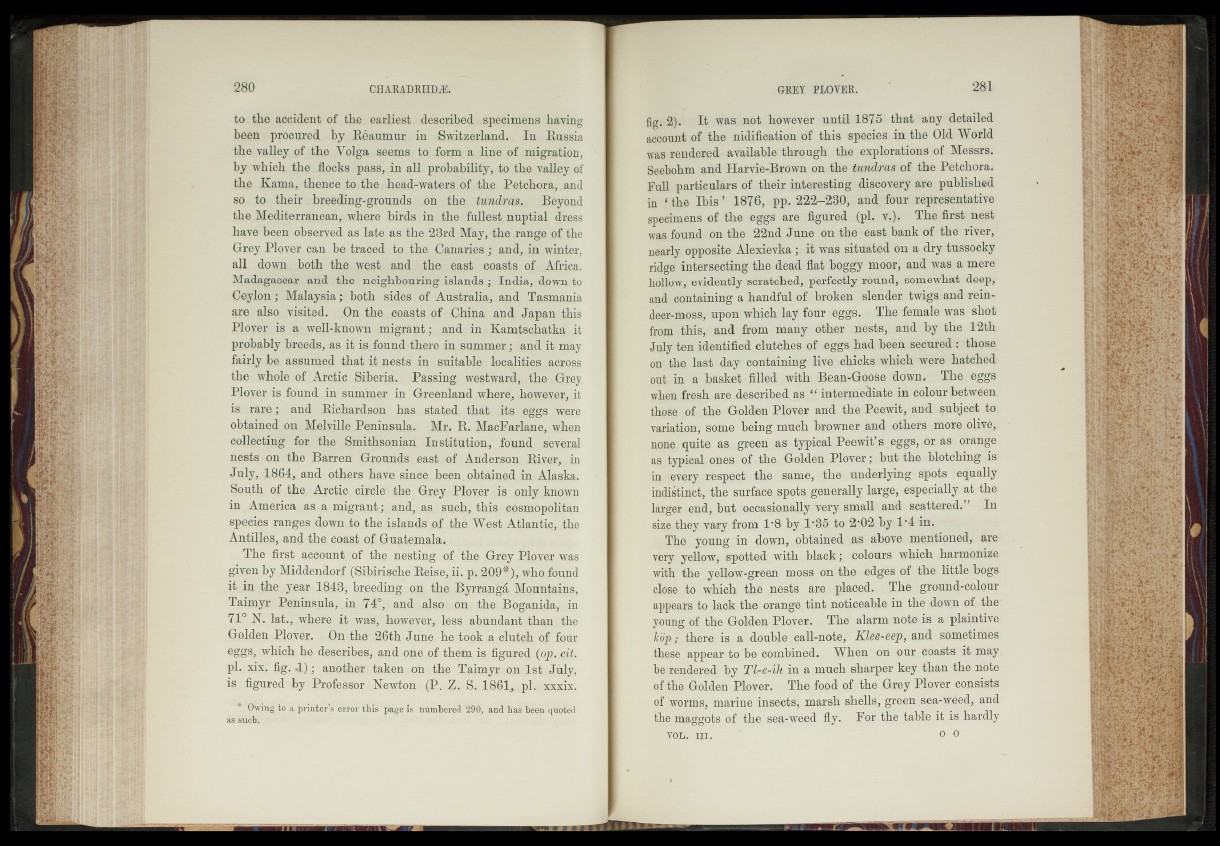
to the accident of the earliest described .specimens haying
been procured -by. Réaumur, in .Switzerland. In Russia
the valley of the Volga seems to .form a line of migration,
by which the flocks pass, in all probability, to the yalley of
th.e Kama, thence to the head-water.s. of the Petchora, .and
so to their . breeding-grounds on .the. tundras,'. ^Beyond
the Mediterranean, where birds in the fullest nuptial dress
have been observed as late as the 28rd May, the..range of the
%ey Ployer can Jbq, traced Jo. the Canaries-; and,-,in winter,
all down. , both the west;,, and the east coasts of^A&’ica.
Madagascar and tbs neighbonring.i.slands.^hdia, down Jo
Ceylon ; Malaysia j| both sides-, of Australia, . and .Tasmania
arse also .visited. . .On th e . coasts. of;±C!hina and Japan this
Ployer is -a;: ] y a P ^ o ^ ,sniigEant ? and in ; Kamtchatka^jtt
probably breeds, as it is. found there in.summerj and it'may
fairly be, assumed that it nests-iin .snitablé'i lofi^lities,..aej:oss
the whole; of Arctic Liberia.-1 Passing westward,, the ^ re y
Plqyer is found |^sumkier in. CreenlandJwherQj3ho.weyer,$it
is rare ; and ,Kichandson; has stated, Jhatyjjjbs \egga
obtained on Melyill.e Peninsula.. .Mr* R. MacFarlane, when
collecting for the Smithsonian Institution, ,foundvÿeyei$l
nests on the barren Grounds^east, of Anderson River,., in
July,,l,8h4> and-others have sin,cejhn,bn;obtained in-Alaska.
§Q.uth: of. .the,,Ajetie circle Jhe GreyrjPlfiyér J s pnlyj^nqwn
in ,America.,as.a/m.igrânti;. and„ as.. such,1 thiStc©smopoldt%n
Species ranges.jdpwn to, the,islands ,of .the; West Atlantic?, Jhe
Antilles, and the coast .of Gnatemala. -
. The first account of gfjpf nesting of the ,Qrey Plqygr, was
given by Middendorf, (^fbirische,Rqis&Ji. p.,2Q9*),,'îyhqJound
|t®in the yqar 1843.;. breeding^ QU tb-A |yrranga. fountains,
Taimyr Pgninsqla, ,in 74°, and alsoiron th e , Boganida, in
71° „N. lat.,.where it,;was, ^however, -less abundantjhanjhe
Golden Plover. QnJhe 2,6th June helto'ek ^cljitch ?^ ^ u r
eggs,. which he describes, and-one.Of them; isjfigjijred
pi. xix. fig. 4) ; another taken on the Taimyr .^onil-st^uly,
is figured by Professor„pe^tony (P.-Z^S$g;861, pi. xxxix.
* 'OWing to a printer’s'error'this page'is ■ numberêff'29®' and has beep qifoted
figr2')V It was not; however until 1875? that any detailed
account of the nidifieation of this species in the Old World
was rendered available through the explorations-of Messrs;
Seehohm and Harvie-Brown on the of the Petchorai
Full particulars of their -interesting discovery are published
in ‘ the Ibis ’ 1876, pp. 222-230; and four representative
specimens of the eggs are figured (pi. v»).- The first nest
was found on the 22nd June on the e,ast bank of -the rtfer*1
nearly opposite Alexievka ; it was situated on a dry tussocky
ridge intersecting the dead flat boggy moor, and' was a hiere
hollow, evidently scratched, perfectly round, somewhat deep,t
and- containing a handful of -hroken- slender twigs and reindeer
moss, upon, which lay four.5eggs. The female was shot
from-,-this,- and from many other -n;qsts|- and by the 12-th
Jid^' ten identified dutches,’ of eggs had been secured; those
on the last- day .containing- live ,-chicks which-were hatched
oii-fc- in a basket?-.filled - with Bean-Gqoser down. Thq .eggs'
when fresh are described as.“, intermediate in Colour .between
those of the Golden Plover and the Peewit, and subject
variation, some being" much browner and -others- .more olive,;
none- quite as- green ^as typical Peew-it’j eggs, -cjr as- qrSSjge
aa^ypical ones qf-the. Golden Plover;-but the blotching is
i§ufever,y»respect the same, -the- underlying*spots equally
indistinct, the surfaca-spsts generally large., especially at- the
larger, end; hut, -occasionady-jery small and scattered;’’ In
sizetbey vary frqapa 1*8 by l'35Jq !|'02 by 1’4 in.
The young in down, obtained :as abo-Ve. mentioned, are-
very yellow,- spotted with, black; colours which harmonize
with the yel-lqw-green moss' on-t-he-redges of’ the* little bqgs,
close, to which the mests .are' placed. - ,-The -ground?coIo!ur
appears to lack the, orange tint noticeable .in! the down of the
young of the Golden-Move».- The alarm-?n-ote?is1 a plain tiv&
hero is a double * call-note,: Khe?e#p>, and sometimes-
these appear tj,0 be combine|l|| When ■* on our coasts, it* may*;
be rendered by /in*a much sharper key than the .note
of the -Golden Plover;. - T-heJood of the G,rey'Plorer consists
of worms, marine insects,- marsh shells, green .sea-weed, and
tbe maggots'of, the sea: weed fly. For the iablb’ if is hardly.